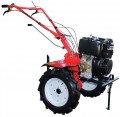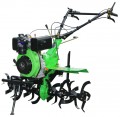Motor type
—
Petrol. Internal combustion engine on gasoline. Such engines have good power, are easy to operate and are not limited by the length of the power cord (like electric ones). Their disadvantages are a significant noise level, exhaust emissions and the need to purchase fuels and lubricants, as a result - a fairly high cost of operation. However, most walk-behind tractors and cultivators have gasoline engines.
—
Diesel. An internal combustion engine similar in design to a gasoline engine, but with a number of differences in the operating principle and, as a result, in operation. Thus, it is fueled with diesel fuel, which is somewhat cheaper than gasoline. Diesel engines have good torque at low speeds, due to which they are well suited for heavy work (plowing, transporting goods). On the other hand, they are not without drawbacks - high cost of repair and high requirements for fuel purity. As a result, diesel walk-behind tractors and cultivators are less common.
—
Corded electric. Electric motors powered by an electrical network, most often a regular household 230 V. The advantages of all electric motors over gasoline/diesel ones are, in particular, low cost (including in operation), smaller dimensions and weight, ease of maintenance (almost none required), low noise level and absence of exhaust gases. On the other hand, their power is relatively low — even for
...models powered by the network it does not exceed 3 kW. Therefore, electric units are mainly made for small volumes of work, which are more like cultivators than full-fledged walk-behind tractors. It is also worth noting here that when powered by the network, the mobility of the unit is limited by the length of the power cord. On the other hand, models with such power are generally more powerful than battery-powered ones, with similar power — lighter and cheaper, and the operating time is practically unlimited.
— Battery. Electric motors powered by batteries. The main features of electric motors are generally described above, and battery power makes the unit as autonomous as possible, independent of sockets and the length of the power cord. At the same time, models with such power are even less powerful than devices connected to the network - most of them do not even reach 1.5 kW. In addition, the battery affects the weight and cost of the unit, and the operating time is limited; charging the battery takes a lot of time and still requires a power source. So it makes sense to use cultivators of this type only when the volume of work is small and there are no sockets nearby; such situations occur extremely rarely, so this option has not become widespread.Number of blades
The number of cutters that the two-wheel tractor is equipped with. Note that for models with active rototillers (see below), this parameter is not indicated: such attachments are removable, and active rototillers with different performance characteristics can be installed on one unit.
Speaking of quantity, a cutter means a separate "asterisk" of several curved knives installed on the working axis of the unit. The number of such “stars” is selected depending on the processing width that the manufacturer wants to provide: one cutter captures a strip on average from 12 to 18 cm, and several of them are needed for a more or less decent working width.
Motor power
Horsepower of two-wheel tractor/cultivator motor. The basic unit of power nowadays is watt, however for petrol and diesel engines (see "Motor type") the more traditional designation in horsepower is often used. 1 hp is approximately equal to 735 watts.
More powerful motor allows achieving higher productivity, width and depth of processing. On the other hand, high power significantly affects the price, weight and dimensions of the unit, as well as the consumption of electricity/fuel. In light of this, the engine characteristics are selected by the manufacturer taking into account what "weight category" the walk-behind tractor belongs to. The most limited modern units have a power of
up to 2 hp, in the heaviest and most advanced this figure can
exceed 13 hp ;
4 - 7 hp can be called an average indicator, and
2 - 4 hp and
7 - 13 hp are below and above average, respectively.
Detailed recommendations on the optimal power for a given situation can be found in specialized sources.
Motor power
The power of the two-wheel tractor/cultivator engine in watts. This designation is usually used for electric engines, but can also be used for petrol/diesel engines, along with horsepower (for more information, see the "Motor power" section above).
More powerful motor allows achieving higher productivity, width and depth of processing. On the other hand, high power significantly affects the price, weight and dimensions of the unit, as well as the consumption of electricity / fuel. In light of this, the engine power is selected by the manufacturer taking into account what "weight category" the walk-behind tractor belongs to, what characteristics it should show. So, the lightest models have a power
of up to 1.5 kW, this is the device that is best suited for a small area of 6 - 8 acres. Walk-behind tractors
up to 3 kW can cope with 10 - 15 acres, a power of
3.5 - 5 kW is suitable for a plot of 50 acres to a couple of hectares. Units
for 5 - 10 kW are already classified as professional level, they can "tame" spaces of 7 - 10 hectares; and the heaviest and most powerful modern walk-behind tractors have a power
of more than 10 kW.
Fuel consumption
The average amount of fuel consumed by the gasoline or diesel engine (see "Engine type") of the cultivator/two-wheel tractor per hour of operation. This value is rather conditional, because depending on the mode of operation, fuel consumption may vary in one direction or another; however, in general, it provides an estimate of the approximate amount of fuel required for a given operating time.

